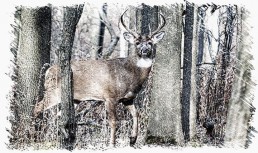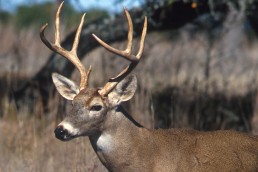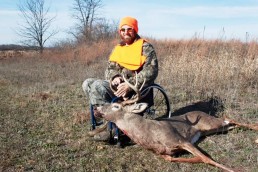Beating the Deer Alert Detection Triad
SHARE THIS POST
Deer have their senses attuned to their environment. Their eyes, ears and noses detect food, mates and danger. These sensors do not work as separate units but are integrated into a network designed to work from within feet up to hundreds of yards away. Fortunately for hunters, deer cannot be on constant alert, and as long as we stay below the threshold of their warning system, we stand a chance to enjoy some venison steak.
In our daily lives humans are principally “visual” beings so we tend to think visually. To a woodland deer, this is probably the last unit of the triad that it uses to verify danger. In a way, it’s the inner circle of the detection network. Vision is limited in direct proportion to the amount of plant mass that is around. In fact, the very dense cover that deer prefer is the same thing that limits the use of their sight for primary detection. Their central command center (i.e. brain) is designed not so much to detect a human shape but to detect unwarranted motion.
How often have you sat quietly and watched a deer approach completely unaware of your location, and then with a slight movement of your hand or head, have that deer instantly zero-in on your spot? If this is the only indication of your presence you may not be busted yet. It takes one or both of the other detection systems to verify that you are a danger.
Hearing has the next greatest range and constitutes the second circle of detection. Sound travels relatively far and is fairly directional in nature. It is also specific enough in character that deer know the difference between a squirrel scampering in the leaves and a hunter shuffling his feet. Up close, they can certainly tell the difference, as bowhunters can attest to, between twigs hitting each other and an arrow clicking on a rest. All creatures have the ability to ignore the normal background noise of their environment. If they didn’t, they would soon reach sensory overload. For instance, we can sleep through a train at 3 a.m., but awaken instantly when we hear the teenager sneak in 15 minutes past a curfew.
You cannot be totally silent when you hunt. What you need to do is make sure any noise you do make conforms to the normal sounds of your surroundings or is reduced. Moleskin placed on your arrow rest, taping of buckles or carpet put on your footrest are just a few that can keep you from making a “hunt-breaking” sound. Remember, except in the wildest of areas, deer hear human-produced sound. They’ll ignore a dog barking or a slamming door if it’s perceived at a distance. It’s the sound that is closer that makes their ears perk forward.
Are you enjoying this post?
You can be among the first to get the latest info on where to go, what to use and how to use it!
Smell is the mainstay of a deer’s detection arsenal. Since odor is unique to each and every thing, deer use it to identify food, mates, rivals and danger and studies show also likely as a means of long-range communication both in distance and time. More brain matter of deer is devoted to smell “interpretation” than the other two senses. It is also the least understood. Deer biologists seem to find new odor-producing glands all the time and a huge industry has developed in producing more scents for the hunter to use to confuse, misdirect and miscommunicate our intensions for sitting in a tree. The problem is that no one can say with any scientific certainly what any of these smells mean to a deer, or how our use of these are interpreted by a deer. One thing is certain: Even though smell is the least directional (over increasing distance), it stays around for hours to days or weeks and human smell has been ingrained as a smell associated with danger.
Any security system has flaws and weak spots that can be exploited. As hunters, we need to take advantage of as many of these as possible. Sight is the easiest to deal with. Through camouflaged clothing and sitting still, we can become all but invisible to a deer. Sound is also easily dealt with. It is impossible to be completely silent when walking, but we can learn how to make our sounds blend into the general background noise. Listen to the common animal sounds squirrels, turkeys and deer make as they walk—their sounds are broken by long pauses. Humans are the only creatures that tend to walk in a smooth or unbroken gait. Emulate the broken pattern of other animals and you will go a long way to being undetected. Make sure that you are quiet up in your treestand too, with no squeaky platforms, no clicking arrows or gun actions.
Smell is probably the hardest sense to deal with. We douse ourselves with masking scent, but we really don’t know if a deer can tell the difference between a genuine “earthy” smell and commercial odors. My belief is that they can. So, good personal hygiene is number one for odor elimination. Next is baking soda. Clean clothes can be stored in bags with local leaves, dirt and branches. Attractant products have their uses, if applied properly. Too much or the wrong type will send the message that a hunter is in the vicinity. Because we are not smell-oriented, we probably overdo with the scents, so I dilute all of mine. Realize everything you touch with skin holds your scent, although how much or the duration is unknown.
The biggest hole in a deer’s security system is also the one easiest to take advantage of: sensory overload. Every creature is inundated with sensory information. If we had to attune to every little sound, smell, touch or sight we would go into total shutdown. So we—and deer—have a safety system. We shut out 99 percent of what our senses receive until a critical level is reached, and then we pay attention to whatever triggered the need for the higher response. I believe that deer more often ignore one sensory response, but become alert when there’s a combination of smell, sound or sight that is induced. If a deer jumped at every single sound experienced or fled at one mere smell of a human they would be a neurotic messes. I have observed deer cross my Cover Scent-covered trail and stop cold; they look around, twitch their ears and test the wind. But when they did not detect any other confirming fact, they placidly moved on. I have had deer move right under my stand too. If the “scent-pooling” theory is correct, they had to have smelled me. And yet, it was not until I made an errant sound or an extraneous motion with that, that they scattered.
It is only that “mythological” hunter that we all strive to be: one that can be perfectly quiet, absolutely invisible and utterly odorless. For my part, I know that if I make one mistake I am still undetected. However, two means it’s decision time: Do I hunker down to keep from adding the third piece to the detection system or go for broke and take a quick shot?
MWO
SHARE THIS POST
Did you enjoy this post?
You can be among the first to get the latest info on where to go, what to use and how to use it!
Doug Thalacker
Doug Thalacker has a Masters of Environment Science from UW-SP and taught high school environmental science and earth science. He has outdoor/wilderness training through Outward Bound and American Red Cross. He has a lifetime of enjoying any activity that involves fields, woods or waters.



